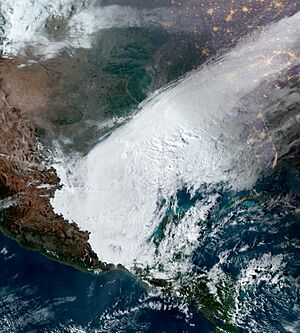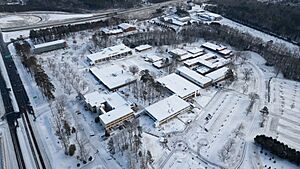2025 Gulf Coast blizzard facts for kids
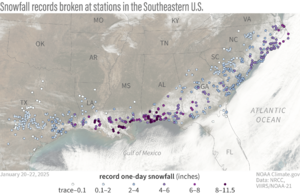
A satellite view combined with snowfall reports shows the Gulf Coast covered in snow after the blizzard on January 22.
|
|
| Meteorological history | |
|---|---|
| Formed | January 20, 2025 |
| Exited land | January 22, 2025 |
| Dissipated | January 27, 2025 |
| Unknown strength tropical cyclone | |
| Regional Snowfall Index: 2.93 (NOAA) | |
| Lowest pressure | 939 mbar (hPa); 27.73 inHg (see Storm Éowyn) |
| Maximum snowfall or ice accretion | Snowfall – 13.4 in (34 cm) near Grand Coteau, Louisiana Ice – 0.25 in (6.4 mm) in Hebbronville, Texas |
| Overall effects | |
| Fatalities | 13 |
| Damage | >$500 million |
| Areas affected | U.S. Gulf Coast, Southeast |
| Power outages | >77,000 |
|
Part of the 2024–25 North American winter |
|
The 2025 Gulf Coast blizzard was a very powerful and rare winter storm that hit the Gulf Coast of the United States from January 20 to 22, 2025. This storm, which later became Storm Éowyn in Europe, brought heavy snow to places that almost never see it. It was the first blizzard ever recorded on the Gulf Coast. It was also the biggest winter storm in the area since the Great Freeze of 1895.
The storm began when cold Arctic air moved over the warm waters of the Gulf of Mexico. This created a powerful storm system that dropped huge amounts of snow and ice along the coast. It moved east from Texas to Florida before heading out to sea on January 22.
Because the storm was so dangerous, states of emergency were declared across the Gulf Coast. This allows governments to respond quickly to disasters. For the first time ever, a blizzard warning was issued for the coasts of Louisiana and Texas. A blizzard is a severe snowstorm with strong winds and low visibility.
The storm caused major problems. Thousands of airline flights were cancelled. Many areas received 6 to 12 inches of snow. Louisiana and Florida both saw their biggest single-day snowfalls in nearly 100 years. The storm knocked out power to over 77,000 homes and businesses. Sadly, 13 people died because of the storm. The total damage was estimated to be more than $500 million.
Contents
How the Storm Formed
On January 21, a storm system formed in the western Gulf of Mexico. It was powered by a blast of freezing air from the Arctic. This mix of cold, dry air and warm, moist air from the Gulf is what created the perfect conditions for a massive winter storm.
The Weather Prediction Center, which forecasts weather for the U.S., called it a "rare winter storm" that would have a big impact. After leaving the U.S., the storm's remains traveled across the Atlantic Ocean. It grew into a new storm named Storm Éowyn. This storm then brought major problems to Ireland and the United Kingdom.
Preparations and Storm Impact
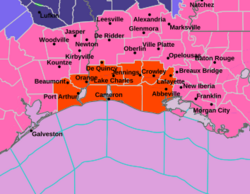 |
|||||
| Blizzard Warning | |||||
| Winter Storm Warning | |||||
| Winter Weather Advisory | |||||
| Freeze Warning | |||||
| Gale Warning | |||||
| Small Craft Advisory | |||||
The National Weather Service (NWS) issued many warnings to help people stay safe. The map on the right shows the different types of warnings, from a dangerous Blizzard Warning to a Small Craft Advisory for boats.
Texas
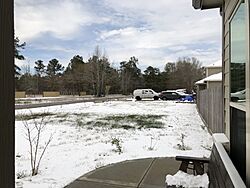
Before the storm hit, Texas state agencies got ready. Airports near Houston stopped all flights. The state's power company worked to prevent major blackouts like the ones that happened in 2021. Houston's mayor, John Whitmire, said that crews were treating roads to make them less icy.
The Houston area saw freezing rain and snow. Up to 6 inches of snow fell near La Porte. The ice and snow made roads very dangerous. Several people died in car crashes, including in a large pileup involving many cars. Space Center Houston closed down for safety. About 1,100 people used county shelters to stay warm.
Louisiana
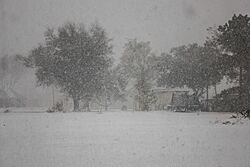
For the first time in history, the National Weather Service issued a blizzard warning for southwestern Louisiana. This was because of heavy snow and winds blowing faster than 35 miles per hour.
The storm dropped an amazing 13.4 in (34.0 cm) of snow near Grand Coteau, the highest amount from the blizzard. The city of New Orleans got up to 10 inches of snow. Baton Rouge received 7.6 in (19.3 cm), breaking a snowfall record from 1895. The extreme cold also set new record low temperatures in several cities.
Major highways like I-10 had to close, stopping traffic. Most flights at the Louis Armstrong New Orleans Airport were cancelled. A basketball game between the New Orleans Pelicans and Milwaukee Bucks was postponed. Schools across the state closed for several days.
Mississippi
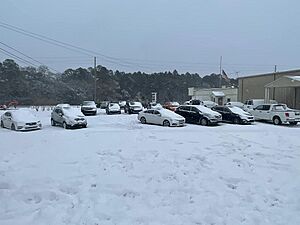
The governor of Mississippi, Tate Reeves, declared a state of emergency on January 19. Shelters were opened along the coast for people who needed a warm place to stay.
The Gulfport-Biloxi International Airport closed because of the snow. Some areas, like Ocean Springs, reported up to 9 inches of snow. Bridges along the coast were closed until the ice melted. Schools also closed for the entire week.
Alabama
In Alabama, the town of Babbie saw 11 inches of snow. The airport in Mobile recorded 7.5 inches, breaking its old record from 1895. In Mobile, the weight of the heavy snow caused the old, empty Mobile Civic Center to collapse.
Georgia
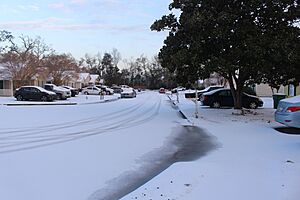
Georgia's governor, Brian Kemp, warned that the storm could cause serious problems in Atlanta. Many schools closed early. Atlanta received about an inch of snow. This was the city's second snowfall in two weeks, after almost seven years with no significant snow.
Southern and Middle Georgia got even more snow. The table below shows how much snow fell in different cities.
| City | Snow Total |
|---|---|
| Albany | 7.5 in |
| Americus | 5.5 in |
| Hawkinsville | 5.0 in |
| Homerville | 4.0 in |
| Warner Robins | 3.5 in |
| Columbus | 3.0 in |
| Macon | |
| Valdosta | 2.2 in |
| Atlanta | 1.1 in |
| Savannah |
Florida
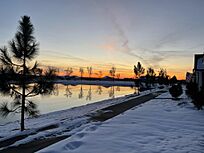
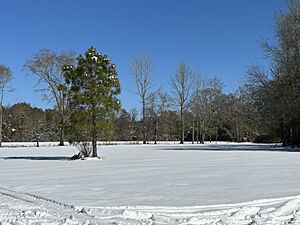
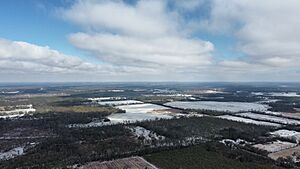
Florida's governor, Ron DeSantis, declared a state of emergency. Government meetings in the state capital were cancelled for the week. The airport in Tallahassee and a long section of Interstate 10 were shut down.
The city of Milton recorded 10 inches of snow. This was more than double the previous state record for a single storm. Pensacola got nearly 9 inches, shattering its old record. It was a historic snow event for the Sunshine State.
The Carolinas
The storm also brought snow to North and South Carolina.
North Carolina
Many parts of southeastern North Carolina reported 4 to 6 inches of snow. At the Wright Brothers National Memorial, a historic site, 9 inches of snow was measured.
South Carolina
In North Myrtle Beach, South Carolina, 4.5 inches of snow fell. This was the biggest snowstorm for the popular beach area since 1989. Warming shelters opened to help people stay safe. The Myrtle Beach International Airport cancelled all flights for almost two days. Roads were dangerous, and emergency crews were very busy.
See also
- Storm Éowyn
- January 2014 Gulf Coast winter storm
- 2004 Christmas Eve United States winter storm
- February 13–17, 2021 North American winter storm
- February 15–20, 2021 North American winter storm
- Snow in Louisiana
- Snow in Florida


